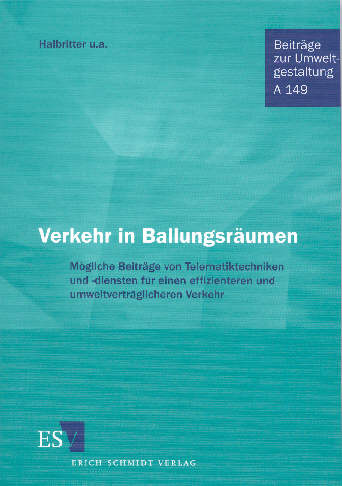Günter Halbritter, Rainer Bräutigam,
Torsten Fleischer, Ekkehard Fulda, Daniela Georgiewa, Sigrid Klein-Vielhauer,
Christel Kupsch
Verkehr in Ballungsräumen. Mögliche Beiträge von Telematiktechniken und -diensten für einen effizienteren und umweltverträglicheren Verkehr. Berlin: Erich Schmidt 2002, (Beiträge zur Umweltgestaltung, Bd. A 149), 207 Seiten, ISBN 3-503-06686-1, € 29,80
Zusammenfassung
[hier]
Inhaltsverzeichnis
[hier]
Vorwort
[hier]
Kurzfassung
[hier]

Subject of the project are new transportation concepts in metropolitan areas, with specific respect to Intelligent Transportation Systems (ITS). The deployment of new technologies and services was investigated within the framework of case studies of projects in different countries and of model calculations for the specific conditions of the Munich metropolitan area. Especially experiences from US projects on ITS deployment show remarkable potentials of these technologies and services to improve the efficiency of the road transport system. However, these potentials can only be realized by a systematic management of these innovative systems. The model calculations show that using new services as, for example, individual dynamic route guidance systems will yield travel time advantages for cars equipped with these systems. These individual advantages will also bring efficiency gains for the whole road traffic system. However, deploying these systems can also have severe impacts on traffic concepts of local authorities as, for example, establishing main roads, arterial roads, or traffic-free areas. Another important result of the model calculations refers to the fact that simple organizational measures, as spreading the time window for commuter traffic in the morning or increasing the occupancy rate of cars, will yield the same or even much larger shortages in travel time for the whole traffic system than the usage of individual route guidance systems by a large number of drivers. Regarding environmental aspects, especially the effluents from traffic, only minor reductions can be achieved using individual route guidance systems. Simple organizational measures as, for example, increasing the occupancy rate of commuter cars yield comparably much larger reductions of the effluents.
Further information (in German),
TA-Datenbank-Nachrichten, Nr.4, 9. Jahrgang - Dezember 2000: